The Palace of Versailles is the most famous royal chateau in France, and the most lavish with its grand Baroque architecture and lavish landscaped gardens. It was the centre of political power and the official royal residence of the court of France from 1682 until 1789.
In the following extensive travel guide on the Palace of Versailles you will get all of your questions answered. We include background information on the history of the palace, outline all that there is to see and do at the palace, provide you with details on how to reach the palace and share some tips on what to expect when you arrive.
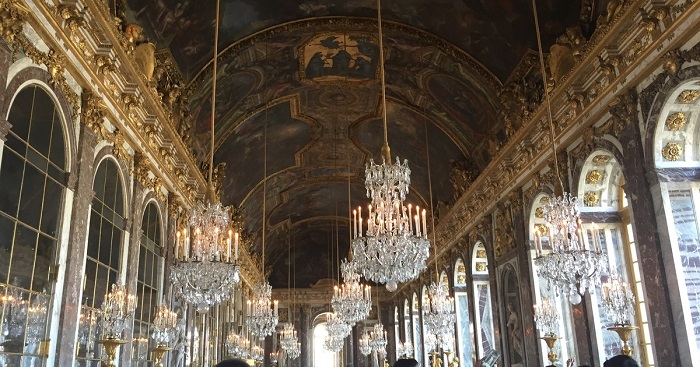
The below table includes a brief description of various handpicked Palace of Versailles tickets & skip the line guided tours of the Palace of Versailles. They're based on users reviews, cost, customer experience as well as all the best ways to see the famous Palace of Versailles sight.
We've compared prices from a variety of skip the line Palace of Versailles guided tours & tickets, websites and have handpicked the most affordable Palace of Versailles combination tickets, but utterly enjoyable Palace of Versailles tours & tickets below:

What Is It
What Will Do
What Inclues
Travellers Talk
Is It Right
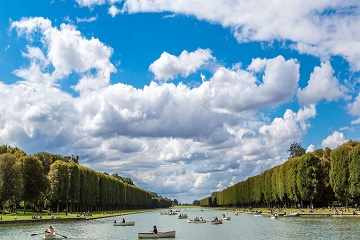
What Is It
What Will Do
What Inclues
Travellers Talk
Is It Right






The Palace of Versailles is a grand former royal residence and former center of government that spans a floorspace of 67,002 square meters with 2,300 rooms, the gardens spanning 800 hectares which includes a 5.57km long artificial canal.
An architectural feat, it was originally a rural hunting pavilion used by King Louis XIII but his son, Louis XIV extended the building, transforming it into an immense and extravagant palace complex with North and South wings, the Grand and Petit Trianon, Chapel and Opera plus stunning French and English landscaped gardens with breathtaking vistas and numerous fountains and statues which took 40 years to complete and became the apogee of palace architecture around Europe.
In 1789 Louis XVI was forced to flee Versailles for Paris due to the start of the French Revolution. The palace was abandoned and never used as a royal residence again, instead becoming the Museum of the History of France in 1837. Its opulent royal rooms were used to house collections of paintings and sculptures, the collections expanding right through until the early 20th century when the central rooms were restored to their original royal residence appearance.
Versailles is the epitome of opulence - It is the symbol of Absolute Monarchy, a symbol of power, wealth, and beauty in an age when France was at the forefront of fashion and power.
It was built to impress everyone who laid eyes on it with no expense spared - So much so that even the chamber pots were made of silver! It is the largest royal domain in the world and still a magnificent sight to behold that tells a powerful tale of political history, grandeur, and royal life.
Being the center of the French Court which consisted of 3,000 individuals including King Louis XVI and Marie Antoinette,other members of the royal family and government ministers, aristocrats, diplomats, and civil servants, it was the backdrop to one the grandest theatres in the whole of Europe with many parties, concerts, games, hunts, and other diversions being the talk of the country for months afterwards.
In more recent history, it was here where the Treaty of Versailles was signed which ended World War I.
The Palace of Versailles is a magnificent example of French Baroque architecture inside and out with an architectural theme of 'creation by diversion' meaning a series of simple repetitions are balanced by the repetition of large windows. The finest furniture and furnishings filled the rooms with quality and expense never spared.
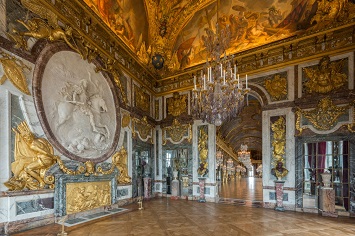
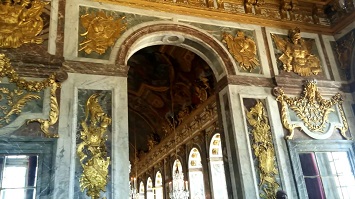
The most important of the historic Galleries, the Gallery of Great Battles is the largest room in the palace covering almost the entire 1st floor in the South Wing. The 33 works of art within cover 15 centuries of the greatest French military successes from Clovis' victory in Tolbiac to Napoleon's victory in Wagram.
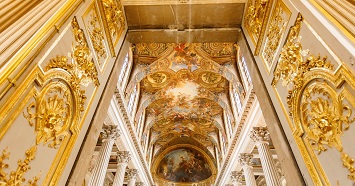
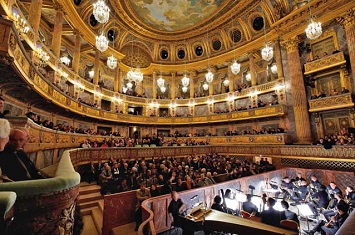
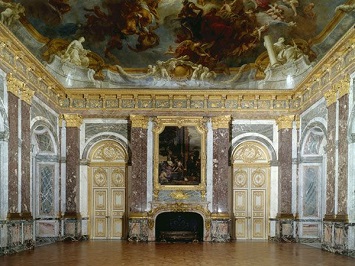
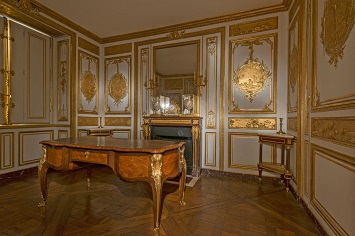
Built at the end of the 19th century, the Congress Chamber is still used today when the members of the National Assembly and the Senate meet in congress. The Vestibule, white with gold touches and featuring large columns has 5 statues from the statue that represent philosophers, poets, painters, and political thinkers.
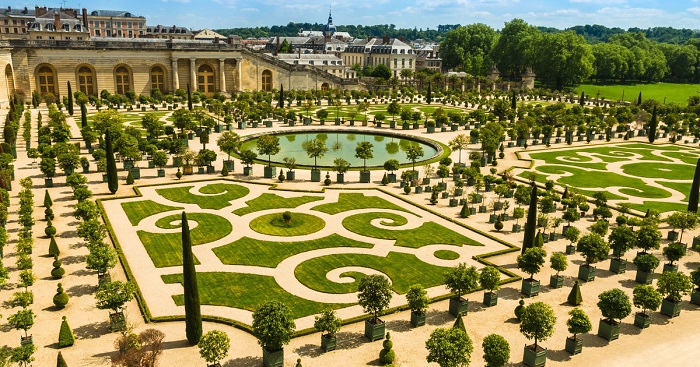
Best viewed from the Hall of Mirrors, the Grand Perspective is the unique East-West facing garden with grand canal (water parterre) leading to the Royal Way that stretches out to the horizon, as far as the eye can see.
The place for entertaining the court outdoors, used as a sort of outdoor salon and a favourite walking place of the Kings, The Groves are miniature parkland gardens with walkways, fountains, statues, and sculptures situated within a larger wooded area, each one enclosed by shrubs and trellises with a gate at the entrance offering visitors surprises around every corner, each one being different in design and style.
The larger of the two 'Pleasure Palaces' built purely for court fun and entertainment rather than official parliamentary and royal engagements, the Grand Trianon is an opulent single-story building of pink marble with arches and columns that was influenced by Italian architecture of the time.
Located in The Estate of Triston (a 30 minute walk from the Palace) stands the complex of buildings used by Marie-Antoinette when she seeked a rural escape from the hustle and bustle of the palace. The Queen's House (cottage) is straight out of a Grimm's Brothers fairytale with rustic looking exteriors containing richly furnished interiors fit for a Queen.
Use this interactive map to see entrances and plan your route around so as not to become overwhelmed at the sheer scale of Versailles http://bienvenue.chateauversailles.fr/en/palace/welcome
Planning Your Visit to the Palace of Versailles
The Palace of Versailles is located 10 miles (16 km) South-West of Paris city center in the department of Yvelines, in the region of Île-de-France.
Public transport options are as follows
Take RER Line C-5 to Versailles Chateau Rive Gauche (indicated as VICK or VITY on the trains) which is an end of line stop. Journey times from central Paris are approximately 30 minutes with trains departing every 15 minutes during daytime operating hours. The station is a 10 minute walk from the Palace and tickets cost 4.10 euro per person each way.
There are 2 options when travelling by SNCF train, both journey times taking between 10-20 minutes.
From Gare Montparnasse to Versailles Chantiers train station - 20 minute walk from the station to the Palace. Tickets cost 3.45 euro each way.
From Gare Saint Lazare to Versailles Rive Droite train station - 30 minute walk from this station to the Palace. Tickets cost 4.20 euro each way.
T+ tickets cannot be used on these journeys but the passes Navigo, Mobilis and Paris Visite covering zones 1-4 can be used.
Operating Tuesday-Sunday there is a shuttle bus departing from the Eiffel Tower. The shuttle bus departs at 7.45am, 9.45am, and 1.30am returning at 3.15pm or 6pm with journey times taking 45 minutes when there is no traffic. Return tickets cost 29 euro.
RATP bus line 171 runs from Pont de Sevres to the Palace of Versailles within 30 minutes when there is no traffic. T+ tickets are accepted, otherwise the cost is 2 euro each way.
Prices depend on the company and the time it takes to arrive, dependant on traffic, but prices are generally between 45-60 euro, the journey taking 45 minutes without traffic.
The Palace and grounds of Versailles are huge so you should dedicate an entire day to look around, this way you will get to see almost everything and won't be rushing as there's more than just the rooms inside the palace and the gardens to see - There is also The Royal Chapel, The Coach Gallery, The Estate of Trianon which contains The Queen's Hamlet and the Grand and Petit Trianon, the huge parkland, and a range of temporary art exhibitions plus daytime and evening shows such as the Fountain Show that takes place on Summer evenings.
The main entrance to the palace with ticket office is located at Grille d'Honneur from where you can also access the gardens at the cour des Princes entrance and then the park. The Estate of Trianon is located about 30 minutes away from the Palace on foot and contains The Queen's Hamlet and the Petit Trianon. The Coach Gallery is a museum located in front of the Palace, across the Place d'Armes, that contains a selection of Royal Coaches from the 19th century.
If only visiting the park there are 3 entrances from the city - The Queen's Gate on Boulevard de la Reine, St Anthony Gate on the D186 and Sailors Gate on the de Saint-Cyr route.
When you book your ticket to Versailles in advance you avoid having to queue twice (once to buy the ticket, and again to gain entrance to the palace which can save you at least 1 hour in each queue, longer during peak Summer visiting times. You can also take advantage of online deals which can save you money - It generally costing more to pay for your ticket on the day from the ticket office at Versailles.
Without a doubt, yes! A visit to Versailles is an all day event and time is precious when you want to see it all. By purchasing a skip-the-line ticket ahead of time you avoid queuing up twice, once for the ticket office, and again to be let inside the rooms. Skip-the-line ticket holders can use the automated ticket barriers avoiding the long snaking line of regular ticket holders although unfortunately no one gets to skip the security line! When combining a skip-the-line ticket with a guided tour of the King's Private Apartments you also get to use a different entrance therefore avoiding the crush of the crowd.
Visiting Versailles during the Spring or Summer allows you to see the gardens at their best when they're in full bloom, but Autumn is another magical time to visit as the trees change colour. However, visiting in the Winter months means less overall visitors.
The best time to view inside the Palace is before 10am (at which point the large tour groups arrive) or after 3pm (when they have left). There are 2 recommended routes for avoiding the most crowds whilst ensuring you see everything:
Take the guided tour of the King's Private Apartments as soon as the palace opens. Then, instead of staying inside the palace to explore at your own pace, head outside to see the gardens and park. From the park you can make the 30 minute walk to the Estate of Trianon which is open from 12.30pm. After this you can go back through the park and gardens, exploring different areas, as you make your way back to the palace. Stop at the Coach Museum first, also open after 12.30pm, and then head back inside the palace rooms after 3pm until closing time or until you feel you've seen everything!
Tuesday is the busiest day at Versailes due to several of the top Paris museums being closed, followed by the weekends. If you visit Wednesday-Friday (Versailles is closed Mondays) outside of July-August you won't have to battle so many crowds.
If you try to see Versailles without any kind of tour (guided or audio) you will miss out on seeing and learning so much and can easily become overwhelmed and lost.
Audio guides are available free of charge (with a ticket purchase) for the Palace, Gardens, and Grounds whether you pick up an audio guide from the front desk or download the audio guide on your smartphone ahead of time but the information they give is brief.
The King's Private apartments (the private rooms of Louis XV and Louis XVI) are only accessible as part of a 90 minute guided tour which this also includes a guided tour of either the Royal Opera House or the Royal Chapel. When booking the private tour (7 euro extra) you are given a time slot and can use a different entrance to other visitors. After the tour you have free time to wander the palace rooms on your own, without needing to go back outside and queue up again.
Splendorous Versailles is another guided tour offered by officials of the palace and lasts for 90 minutes. On this tour, visitors are shown the King's Chamber, the Hall of Mirrors, and much more whilst learning about the history of the rooms, and the people who used them.
On the Trilion Estate, the interior of the Queens House, can only be accessed as part of a guided tour, there is also a guided tour that explains the significance of the Petit Trianon, a place of refuge for Queen Marie-Antoinette, that takes visitors around the exterior only.